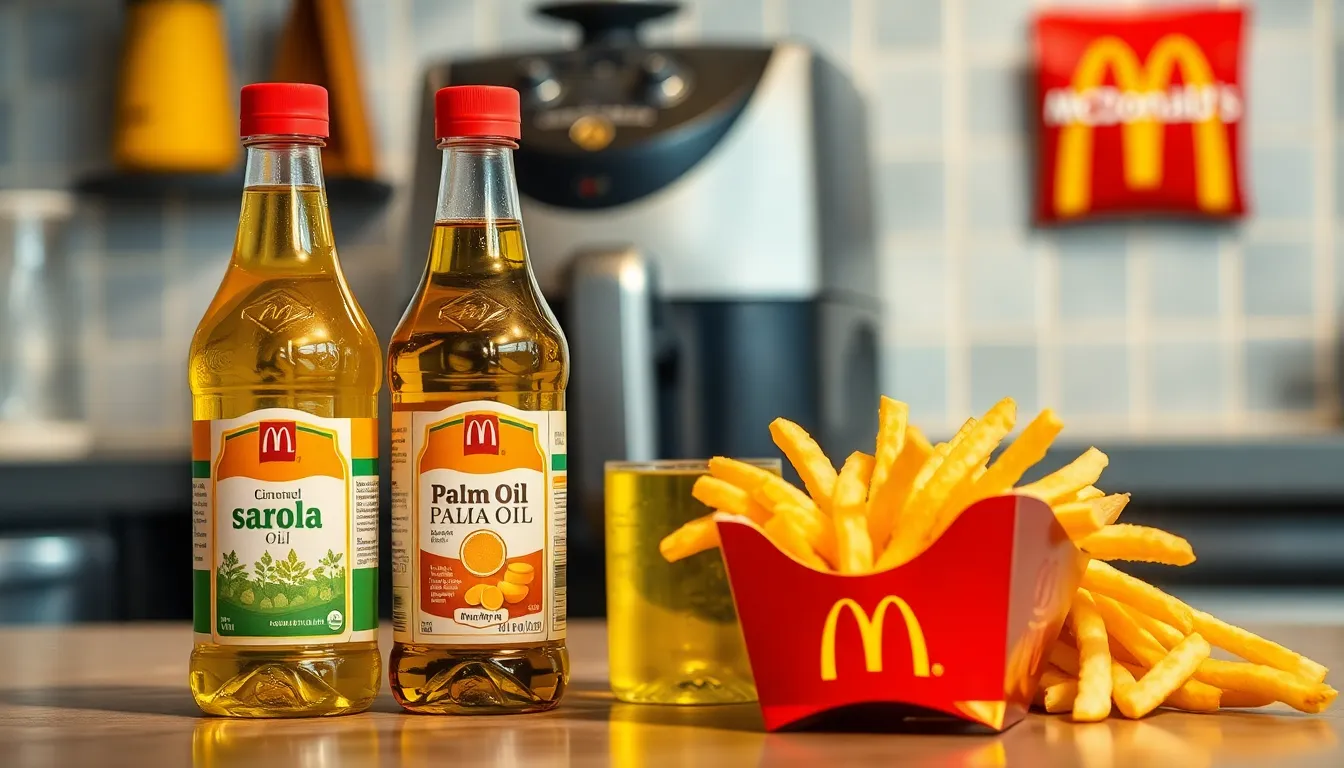When it comes to fast food, McDonald’s reigns supreme, but have you ever wondered what fuels those golden, crispy fries? It’s not just magic; it’s the oil! The choice of oil can make or break the flavor and texture of those iconic fries, and McDonald’s takes it seriously.
So, what kind of oil does this global giant use? Spoiler alert: it’s not just any oil you’d find in your kitchen. The secret ingredient behind that irresistible crunch is a carefully selected blend that keeps customers coming back for more. Dive into the delicious details and discover how McDonald’s oil choice plays a pivotal role in creating the mouthwatering experience we all crave.
Table of Contents
ToggleOverview of McDonald’s Oil Use
McDonald’s utilizes a blend of canola oil and soybean oil for frying. This specific combination enhances the flavor and texture of their iconic fries. Canola oil stands out for its high smoke point, making it ideal for cooking at high temperatures. Soybean oil contributes to the overall taste and creates a crisp exterior.
The oil blend is designed to meet quality standards and improve the frying process. Each batch of fries gets cooked in oil that contains natural flavors, which adds to the overall experience. McDonald’s maintains consistency in its oil selection across locations to ensure uniformity in taste.
In addition to the core oils, the frying process involves the inclusion of dimethylpolysiloxane, a food-grade anti-foaming agent. This ingredient prevents foaming during frying, thus maintaining oil quality. The oil also undergoes regular testing to ensure it meets safety and quality guidelines.
Sustainability features into McDonald’s oil use strategies, with the company exploring options to source oils responsibly. Transparency is a priority; customers can find nutritional information regarding oil use on the company’s official website. This commitment reinforces their dedication to providing high-quality food cooked in responsible oils.
Types of Oils Used by McDonald’s

McDonald’s employs a mix of oils crucial for the signature taste of its menu items. The main oils include canola oil, soybean oil, and palm oil, each playing a specific role in food preparation.
Canola Oil
Canola oil features a high smoke point, making it suitable for frying foods at elevated temperatures. This property allows for consistent cooking and enhances the crispiness of items like fries. The oil’s light flavor profile contributes to the overall taste without overpowering the food’s natural flavors. Additionally, canola oil contains less saturated fat than various alternatives, aligning with health-conscious initiatives. Selecting this oil helps McDonald’s maintain quality and adhere to dietary guidelines.
Soybean Oil
Soybean oil plays an essential role in McDonald’s frying process, offering a flavor that complements other ingredients. This oil type contributes to achieving a golden-brown color and crispy texture for fried items. It also acts as a stabilizer, ensuring consistent frying performance across various locations. With a blend of polyunsaturated and monounsaturated fats, soybean oil supports the restaurant’s commitment to using oils with favorable nutritional profiles. Regular testing ensures this oil meets safety and quality standards demanded by McDonald’s.
Palm Oil
Palm oil varies in use within McDonald’s products and can be responsible for enhancing texture and flavor. Rich in flavor and often considered versatile, palm oil caters to both frying and ingredient formulation. The company’s commitment to sustainability guides its sourcing choices for palm oil, ensuring responsible practices while meeting quality demands. Transparency in sourcing addresses customer concerns about environmental impacts, reinforcing McDonald’s goal for ethical ingredient use. This focus on palm oil aligns with their broader strategy to improve food quality while prioritizing responsible practices.
Health Considerations
Oil choice impacts health, making it essential to consider the nutritional aspects of McDonald’s frying oils. Each type of oil provides distinct health benefits. Canola oil contains lower saturated fat levels, promoting heart health. It also includes omega-3 fatty acids, which may reduce the risk of cardiovascular diseases. Soybean oil contributes beneficial fats and increases vitamin E levels. Palm oil, while higher in saturated fats, supports texture and flavor but requires moderation. McDonald’s commitment to transparency includes providing nutritional information for customers seeking healthier choices.
Nutritional Aspects
Each oil used at McDonald’s offers nutritional components that align with health trends. Canola oil features an average of 7 grams of fat per tablespoon, primarily made of monounsaturated fats, contributing to lower cholesterol levels. Soybean oil provides around 14 grams of fat per tablespoon, with a significant percentage consisting of polyunsaturated fats which may support brain health. Palm oil adds flavor but contains about 14 grams of fat per tablespoon, impacting overall dietary fat intake. McDonald’s strives to balance flavor and nutrition, ensuring that customers enjoy their meals while being mindful of health needs.
Allergies and Sensitivities
Many customers have allergies or sensitivities, including those related to oils used in food preparation. Canola oil and soybean oil are generally regarded as safe, with instances of allergies being rare. Awareness of potential allergies can guide choices; however, cross-contamination may occur. Palm oil is less likely to trigger allergies but attention to individual sensitivities is crucial. McDonald’s actively encourages customers to review their ingredient lists to make informed decisions. Customers concerned about allergies or sensitivities should consult McDonald’s nutritional guides for detailed information.
Sustainability Practices
McDonald’s emphasizes sustainable practices in sourcing oils. The company actively strives to ensure that its oils align with ethical standards and contribute to global sustainability efforts.
Sourcing and Ethics
Responsible sourcing defines McDonald’s approach to oil procurement. They work with suppliers to promote sustainable farming practices, focusing on traceability and transparency. Certification from organizations like the Roundtable on Sustainable Palm Oil helps verify the sustainability of palm oil. This commitment reinforces their dedication to environmental stewardship and minimizing social impact. Collaboration with stakeholders drives continuous improvement in supply chain practices, ensuring that oil sourcing benefits both the environment and local communities.
Environmental Impact
Reducing environmental impact remains a key priority for McDonald’s. The company focuses on minimizing greenhouse gas emissions related to oil production and transportation. Sustainable practices, such as using responsibly produced palm oil, play a significant role in this strategy. McDonald’s aims to prevent deforestation and protect biodiversity through its sourcing decisions. Additionally, oil management practices, including recycling and filtering used oil, contribute to waste reduction. McDonald’s commitment to sustainability demonstrates its responsibility towards the environment and society.
McDonald’s commitment to quality and sustainability is reflected in their choice of frying oils. By using a blend of canola, soybean, and palm oils, they achieve the perfect balance of flavor and texture in their iconic menu items. This careful selection not only enhances the taste of their food but also aligns with health and environmental considerations.
The company’s dedication to transparency and responsible sourcing practices further underscores its efforts to provide customers with nutritious options while minimizing their ecological footprint. As consumers become more conscious of what they eat, McDonald’s continues to adapt and share information about their ingredients, ensuring that everyone can enjoy their meals with confidence.





